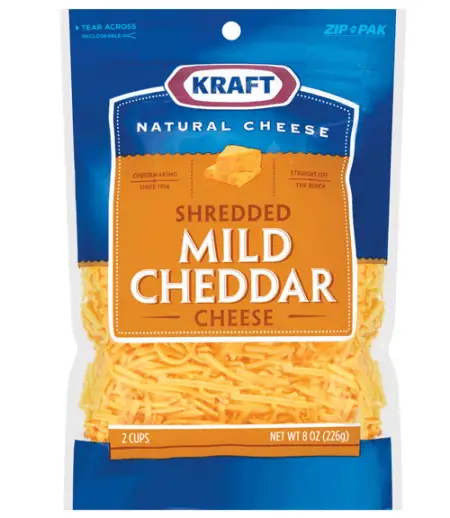Cheddar cheese is one of the most common types of cheese on the market today. But even choosing the most readily available type of cheese can be confusing, especially when you have to choose between sharp and mild cheddar. Are they the same? This article will discuss the difference between sharp and mild cheddar cheese.
Summary Table
| Sharp Cheddar | Mild Cheddar |
| Aged for approximately one year | Aged for two to three months |
| Dry and crumbly; can be hard to melt | Softer, smooth; easier to melt |
| Powerful tangy flavor which some may consider unpleasant | Mild flavor with a note of tanginess |
Descriptions

Sharp cheddar cheese is simply cheddar cheese that has been aged for about a year. Since aging causes the cheese to lose moisture, sharp cheddar cheese is dry and has a crumbly texture. Sharp cheddar cheese can be difficult to melt because of its low moisture content. As the name suggests, it has a sharp, acidic, tangy flavor which may be undesirable to some people. Many people say sharp cheddar cheese is an acquired taste.
As the cheddar cheese ages, naturally occurring bacteria produce more enzymes that break down the cheese proteins and fats. This process sometimes gives sharp cheddar cheese its nutty flavor. However, some types of cheddar cheese can have a hint of bitterness or sweetness too, as the source of the milk used to process the cheese is also a factor that affects the flavor of the cheese.

Mild cheddar cheese is cheddar cheese that is aged for 2 to 3 months. As the name suggests, mild cheddar cheese has a mild flavor but it does still have a note of tanginess.
Since mild cheddar is not aged for a very long time, it is moist enough to give a smooth and soft texture. It also melts easily and is gentle on the palate, even to those who are new to cheddar.
Sharp vs Mild Cheddar
What, then, is the difference between sharp and mild cheddar?
The most obvious differences between sharp and mild cheddar cheese are their texture and taste. Aging causes the water to evaporate from sharp cheddar so it is dry and crumbly. It can be hard to melt as well. As it ages, the naturally occurring bacteria in it also causes the protein and fats to break down, resulting in an intense tangy flavor. Mild cheddar cheese, on the other hand, is softer, smoother, and easier to melt. It also has a milder taste but still has a note of tanginess.
The greatest difference (also one that most people do not know) between sharp and mild cheddar cheese, however, is how long they are aged. Sharp cheddar cheese is aged for approximately twelve months, whereas mild cheese is aged in two to three months.
What Do Sharp and Mile Cheddar Cheese Have in Common?
Mild and sharp cheddar cheese are not the same; however, they have some things in common.
Origin
Cheddar cheese comes from the Cheddar (a town) in Somerset, England. It was first developed in the 12th century. Researchers believe that the first cheddar cheese was white and that its yellow color came from later production processes.
Cheddar cheese is one of the most popular cheeses around the world!
Appearance
There are two different color varieties for cheddar cheese (mild or sharp)—white and yellow. White cheddar is the natural color of cheddar cheese. Yellow cheddar is made with the addition of annatto to the cheese. It’s used to control the coloring of the cheese and make it a more uniform pigment.
How Cheddar Cheese is Made
Cheddar (sharp or mild) starts out like many other cheeses. Rennet is added to milk to create curdles. The curds are cut into pieces, pressed, and continuously flipped to remove as much liquid (whey) as possible. The remainder of the cheese is dense, dry, and looks more like crumbled cheddar. The last step of the cheddar cheese process is the aging process. As noted earlier, mild cheddar has a shorter aging process than sharp cheddar.
Uses of Cheddar Cheese
Mild and sharp cheddar are versatile cheeses that can be used in many ways. However, mild cheddar does melt better than sharp cheddar, which can impact which type of cheese is used.
Mild cheddar is often used in dishes such as grilled cheese sandwiches, macaroni & cheese, casseroles, and more. On the other hand, sharp cheddar (which is drier) is used for grating. Grated sharp cheddar is often used in salads, baked potatoes, and more.





